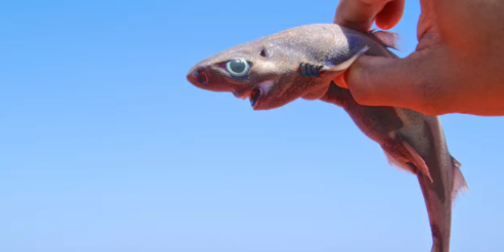http://2.bp.blogspot.com/-YxpXRFlxBiQ/Wjm8ufRNaEI/AAAAAAAAMhQ/L1LezLQurJkmDtEREV-5qpDbfjY0xsSSACK4BGAYYCw/s1600/2017-12-20_6-57-56.png

Earlier this year a new species of deep water shark, Etmopterus lailae, was discovered in waters surrounding the Northwestern Hawaiian Islands in the Pacific Ocean.
Measurements of external features, teeth, vertebrae and intestines, along with specific external markings and patterns confirmed that it was indeed a new species – a member of the lanternshark family. Lanternsharks (Etmopteridae) are one of the most species-rich shark genera, with approximately 38 known species, 11 of which have been described since 2002.
The lanternsharks are one of two deep sea shark families to possess the ability to bioluminesce – in other words, they are able to glow in the dark. The other shark family with the ability to do this are the kitefin sharks (Dalatiidae). This family houses the infamous cookie cutter shark, which was known for its impressive ability to disable US Navy submarines in the 70s and 80s, by testing how the electrical cables and rubber sonar domes rated on a culinary scale (Johnson 1978). Imagine being the officer who had to report back about how the submarines were defeated by a particularly voracious … 22 inch (56cm) shark!

What is bioluminescence and what use is it?
Bioluminescence is the emission of light as a result of a biochemical reaction. In contrast to fluorescence and phosphorescence, bioluminescenct reactions do not require the initial absorption of sunlight or other electromagnetic radiation by a molecule or pigment to emit light.
It is a phenomenon that has been documented in over 700 genera of animals, with the vast majority living in the ocean. In fact, there are a known 29 independent evolutionary events of bioluminescence in marine fish lineages alone.
Bioluminescence in vertebrates is found exclusively among fishes living in marine environments. At present the only known terrestrial animals capable of bioluminescence are arthropods, whereas in marine environments, bioluminescence has evolved from bacteria to vertebrates (Davis et al 2016).
It is also worth noting that bioluminescence is not just exhibited by deep sea dwellers existing in perpetual darkness. A study by Martini and Haddock published earlier this year analysed 17 years of video footage taken from the sea’s surface down to a depths of almost 4000 metres. Observations showed that the percentage of bioluminescent animals is remarkably uniform regardless of depth.

Most fish bioluminesce by using their light organs (photophores) in one of two ways: harnessing the light produced by symbiotic bacteria or producing their own light through chemical reactions. However, shark luminescence works in a different way.
The velvet belly lantern shark (Etmopterus spinax) was used as a model for experimental studies on shark luminescence. It emits visible light from thousands of tiny epidermal photogenic organs – photophores – which are made of a cluster of photogenic cells called photocytes.
The organisation of the photophores strongly suggests that they are involved in varied behaviours, including anti-predatory response (camouflage) and intraspecies communication.
To be ecologically successful, however, this bioluminescence needs to be properly controlled. Again, using the velvet belly lanternshark as a model species it was discovered that shark photophores are controlled by two different substances: hormones and neurotransmitters.
A publication by Claes and Mallefet reviewed these studies. When looking at luminescent switch-on in relation to behavioural usage, they reported that the switch on is induced by two hormones, both of which are involved in elasmobranch physiological control of colour change. One, melatonin, is produced by the pineal gland and the other, prolactin, by the pituitary gland.
These hormones however, operate in different ways. Melatonin induces a slowly increasing long-lasting glow (several hours), while prolactin induces a quicker glow which generally reaches a peak in brightness after 20 minutes and ends after about an hour.
It is thought that this difference in operation reflects a different use of these hormones. Melatonin would be involved in a type of camouflage known as counter-illumination, ie light produced in such a way as to remove the shark’s silhouette from anything below it looking up. Prolactin would be involved in more periodic behaviours such as cohesive swimming or hunting – or even sexual communication. After all, when it is so dark you cannot identify members of the same species, never mind the same sex, glowing genitals are presumably a very handy thing to have!
References
Ebert, D.A. Papastamatiou, Y.P. Kajiura, S.M. Wetherbee, B.M. 2017. Etmopterus lailae sp. Nov., a new lanternshark (Squaliformes: Etmopteridae) from the Northwestern Hawaiian Islands. Zootaxa 4237 (2) 371-382.
Johnson. C.S. 1978. Sea creatures and the problem of equipment damage. US Naval Institute Proceedings. 106-107.
Martini, S. Haddock, S.H.D. 2017. Quantification of bioluminescence from the surface to the deep sea demonstrates its predominance as an ecological trait. Scientific Reports 7:45750.
Davis, M.P. Sparks, J.S. Smith, W.L. 2016. Repeated and widespread evolution of bioluminescence in marine fishes. PLoS ONE 11 (16): e0155154.
Claes, J.M. Mallefet, J. 2011. Control of luminescence from lantern shark (Etmopterus spinax) photophores. Communicative & Integrative Biology 4:3, 251-253.
guardian.co.uk © Guardian News & Media Limited 2010
Published via the Guardian News Feed plugin for WordPress.
Glow in the dark sharks: new species discovered in Hawaii – and it glowshttps://goo.gl/J6C2HS











0 comments:
Post a Comment